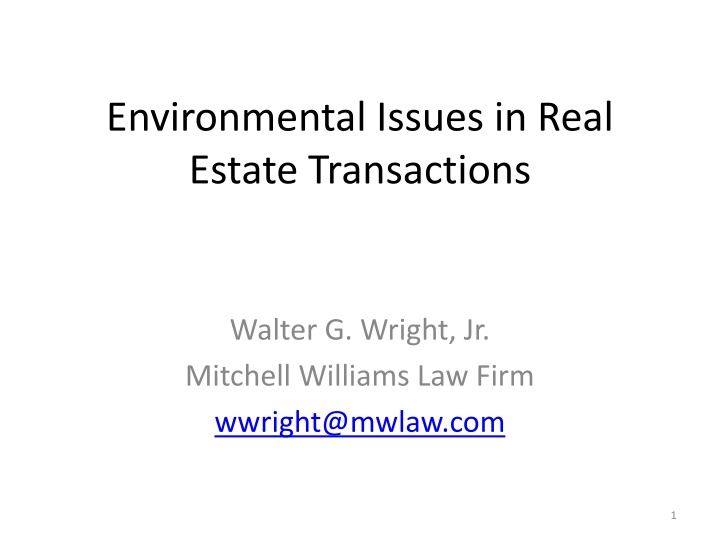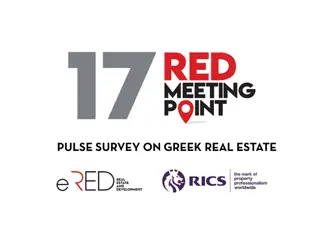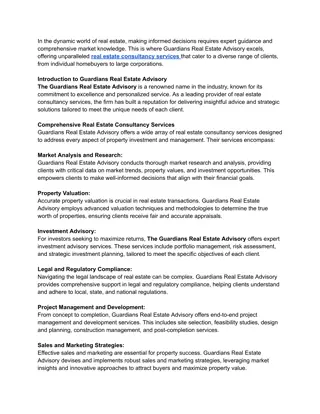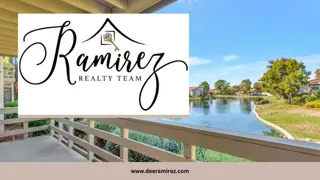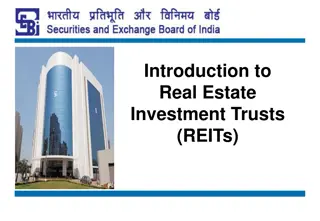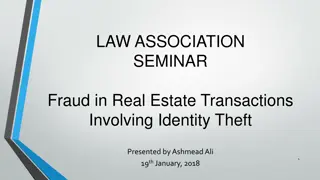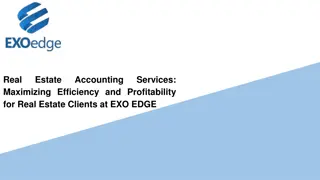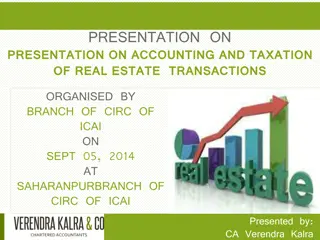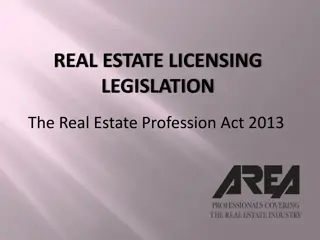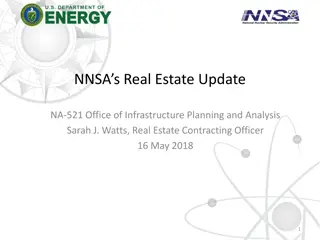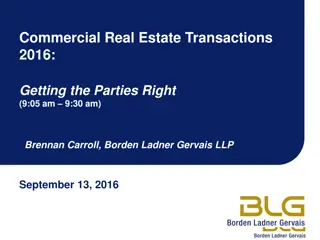Addressing Environmental Issues in Real Estate Transactions: Role, Tools, and Considerations
Environmental issues play a crucial role in commercial transactions, with perceptions often as significant as realities like mold or asbestos. Today, these issues are more routinely addressed, thanks to improved assessment techniques, government efforts, and liability principles. Attorneys guide clients based on transaction type, party represented, issue materiality, tools available, and risk appetite. Understanding and addressing environmental concerns are vital in navigating real estate deals effectively.
Uploaded on Oct 11, 2024 | 0 Views
Download Presentation

Please find below an Image/Link to download the presentation.
The content on the website is provided AS IS for your information and personal use only. It may not be sold, licensed, or shared on other websites without obtaining consent from the author.If you encounter any issues during the download, it is possible that the publisher has removed the file from their server.
You are allowed to download the files provided on this website for personal or commercial use, subject to the condition that they are used lawfully. All files are the property of their respective owners.
The content on the website is provided AS IS for your information and personal use only. It may not be sold, licensed, or shared on other websites without obtaining consent from the author.
E N D
Presentation Transcript
Environmental Issues in Real Estate Transactions Walter G. Wright, Jr. Mitchell Williams Law Firm wwright@mwlaw.com 1
Source of information that often addresses issues relevant to the environmental and/or energy aspects of commercial and industrial properties Arkansas Environmental, Energy and Water Law Blog http://www.mitchellwilliamslaw.com/#home Three posts five days a week Slides will be posted on this blog later this week 2
Role of Environmental Issues in a Commercial Transaction Materiality will obviously vary from deal to deal. Perception of issue as material is as important as reality. (Examples mold or asbestos) Trap to be avoided is reducing efforts to address environmental issues based on lower value of facility or property. Client must make that choice being fully advised of risks. 3
Addressing Environmental Issues Today It is arguable that many environmental issues that were formerly deemed potential deal breakers or unquantifiable are now routinely addressed in the same manner as other transactional tasks such as title searches, appraisals, et. This is due, in part, to developments such as: Familiarity; Improved ability to quantify environmental issues; Experience; Revised or clarified liability principles; Improved assessment techniques; Easier access to government records; Standardized assessment; Efforts by the federal and state agencies to reduce, to the extent possible, the environmental regulatory/liability impediments to financing and/or acquiring/leasing existing facilities ( brownfields programs); and Governmental trust funds A number of tools and/or information unavailable 25 years ago have placed transactional players in a position to better identify, quantify, manage and resolve environmental issues. However Some of these tools or routines can pose risks if there is not consideration of issues that may not be addressed or identified. 4
The measures an attorney advises a client to undertake to address an environmental issue in a transactional context will obviously depend on: Type of transaction (lease, buy/sell/financing, asset v. stock, etc.) Party represented (buyer, seller, lessor, lessee, secured creditor, investor, etc.) Type and materiality of the environmental issue in the context of the transaction Relative leverage of the Client Tools reasonably (cost-effective?) available to allocate responsibility and/or quantify issue Client appetite for risk? (does client understand that compliance and/or agency blessing does not necessarily mean that in the appropriate scenario third party lawsuits or impacts on future bank financing might be an issue?) 5
Environmental Liability Quantification and/or Clarification Amount of corrective action/third party claim Potential value of project/property Costs associated with permits/authorization Costs to determine/quantify/clarify the previous three items Legal, technical, etc. 6
Risks? Not Just Civil. Wetlands-Mississippi: Corporation Pleads Guilty to Illegally Filling Protected Wetlands The United States Department of Justice has issued a press release stating that Mississippi-based Hancock County Land, LLC pleaded guilty to the unpermitted filling of wetlands near Bay St. Louis, Mississippi. HCL agreed to pay a one million dollar fine and take remedial measures for two alleged felony violations of the Clean Water Act. The DOJ news release states that HCL admitted causing the unauthorized excavation and filling of wetlands on a 1,710 acre parcel of undeveloped property in Hancock County, west of the intersection of Route 03 of Interstate 10. The news release also states that when HCL purchased the property, it had been informed by a wetland expert that as much as 80% of its land was federally protected wetland connected by streams and Bayous to the Gulf of Mexico and, therefore, that the property could not be developed without a permit from the U.S. Army Corps of Engineers. The news release alleges that in spite of additional notice of the prohibition against filling and draining of wetlands without authorizations, HCL, principally through its minority owner/general contractor, hired an excavation contractor to trench, drain and fill large portions of the property to lower the water table and destroy the wetland that would otherwise would have been an impediment to commercial development. 7
I. Language Issues A. Buyer/Seller Objectives 1. Buyer Objectives Objective is to purchase property without any responsibility for pre-existing environmental contamination and conduct due diligence with any expansion plans for the facility in mind. Broad environmental representations and warranties and indemnities from Seller; Escrows or purchase price reduction to address known environmental conditions; Ability to control type and timing of cleanup; Ability to conduct a Phase; Determine whether Phase II will be needed/allowed; and Determine whether environmental insurance is warranted and, if so, if it is available and at what cost NOTE: Lender requirements also relevant 8
Language Issues (continued) 1. Seller Objectives Objective is to sell property as is with full releases and indemnification from the Purchaser with minimal impact upon price. Limited or no environmental reps and warranties and indemnities; Broad release from the purchaser; Control type and timing of cleanup; Make Purchaser responsible for any change in use of the property; Prohibit certain uses on the site (e.g., day care centers, residences, schools, parks); and Place a total economic cap on any claim arising from the agreement. 9
Language Issues (continued) B. Critical for Client/Buyer to recognize Language will not always address future scenarios 1. Construction/404 2. Expanded/modified operation air/water permit 3. Change in ambient standards 4. Water Rights Included? See 1st Natl. Bank of Wynne s v. Twin Creeks (collateral include water rights?) 10
Language Issues (continued) C. Warranty 1. Compliance With Environmental Laws a) Timing Scenarios i. Current? ii. Past? iii. Future? 11
Language Issues (continued) Warranty/Compliance (continued) b) Full/material/knowledge (qualifier)? c) Current/Former Facilities Owned/Operated/Leased i. Knowledge of historical operations ii. Relevance to buyer in asset purchase? d) Off-site Issues i. CERCLA/Waste Vendors ii. Equipment leased/supplied a. Tanks b. Cleaning Equipment 12
Language Issues (continued) Warranty/Compliance (continued) e) Issues Not Addressed? i. Asbestos/Lead-Based Paint ii. Mold iii. Radon 13
Language Issues (continued) Warranty/Compliance (continued) f) Remediation Issues i. Historical Contamination ii. Tying Investigation/Remediation Triggers to Agency Approval? 14
Warranty (continued) Example (Buyer s Perspective) Seller is, and at all times has been, in full compliance with, and has not been and is not in violation of or liable under, any Environmental Law. Neither Seller nor any Shareholder has any basis to expect, nor has any of them or any other Person for whose conduct they are or may be held to be responsible received, any actual or threatened order, notice or other communication from any Governmental Body or private citizen acting in the public interest or failure to comply with any Environmental Law, or of any actual or threatened obligation to undertake or bear the cost of any Environmental, Health and Safety Liabilities with respect to any Facility or other property or asset (whether real, personal or mixed) in which Seller has or had an interest, or with respect to any property or Facility at or to which Hazardous Materials were generated, manufactured, refined, transferred, imported, used or processed by Seller or any other Person for whose conduct it is or may be held responsible, or from which Hazardous Materials have been transported, treated, stored, handled, transferred, disposed, recycled or received. 15
Transactions (continued) Warranties (continued) 2. Negative Declarations a) No Hazardous _____________? b) No tanks? i. Active ii. Previously closed a. Pre-1989 b. Post-1989 c) No Releases (spilling, leaking, leaching, etc. of any amount)? i. Too Broad? ii. Too Narrow? 16
Warranty (continued) Negative Declaration (continued) Example (Buyer s Perspective) There is no Hazardous Materials present on or in the Environment at any Facility or at any geologically or hydrologically adjoining property, including any Hazardous Materials contained in barrels, aboveground or underground storage tanks, landfills, land deposits, dumps, equipment (whether movable or fixed) or other containers, either temporary or permanent, and deposited or located in land, water, sumps, or any other part of the Facility or such adjoining property, or incorporated into any structure therein or thereon. Neither Seller nor any Person for whose conduct it is or may be held responsible, or to the Knowledge of Seller, any other Person, has permitted or conducted, or is aware of, any Hazardous Activity conducted with respect to any Facility or any other property or assets (whether real, personal or mixed) in which Seller has or had an interest except in full compliance with all applicable Environmental Laws. 17
Language (continued) D. Releases/Disclaimers 1. As Is Limitations 2. Federal/ASWMA Private Right of Actions 18
Language (continued) Releases (continued) Ted Barnett, et al, respondents-appellants, v. Jeffrey L. Schwartz, et al, appellants- respondents Supreme Court of New York The clients wanted a commercial property to manufacture barbecue sauce. The clients alleged that the attorneys were aware that the property was designated a hazardous waste site but neglected to discuss it with the clients and encouraged the clients to sign an as is lease. Court found that the clients needed to prove only that the defendant-attorney s negligence was a proximate cause of damages. 19
Language (continued) E. Leasing Issues 1. Storage Tank Eligibility (owner/operator) a) Practical Limitations of Lease Terms? b) What if Lessee fails to report/monitor? 2. Can Lessee Carve out or Avoid Operator Status? 3. Lessor/Lessee Set A Baseline? 4. Holdover/Remediation/Rent Issues 20
Lease (continued) 5. Hazardous Materials Language Issues The lease should contain an express prohibition against the manufacture, storage, disposal, transportation, and use of hazardous substances on or around the leased premises. If a tenant must engage in activities involving hazardous substances, the lease should require the tenant to notify the landlord that its activities involve such substances, to covenant to act appropriately, and to indemnify the landlord. Leases typically require express prior written consent from the Lessor prior to the Tenant engaging in an activity which constitutes a Reportable Use of a Hazardous Substance. Tenants should carefully peruse this requirement as it is easy to unintentionally violate. Audit issues. 21
III. Assessment/Due Diligence A. Purpose? To access the innocent landowners/BFP defense under Comprehensive Environmental Response, Compensation, and Liability Act (CERCLA) To assess environmental liability and cost issues To quantify the extent of contamination and determine costs before/after purchase for use in negotiations To identify existing or potential environmental hazards To identify whether or not a neighboring property has the potential to impact the subject property To determine if further investigation is required To discount purchase price Is desired activity feasible/possible/ 22
Environment Assessment/Services Mistake/Scope Examples: - What is the scope of work? - Do both parties have the same understanding? - Do the professionals, being utilized, have both the authority and expertise to address these issues? 23
B. What is the Attorneys Role? 1. Defined? 2. Importance of Confirming Risk/Business Decisions 24
Transactional Issues: Environmental Due Diligence Associated With A Bond Issue/Dispute Regarding Responsibility The development of facilities, properties, and/or districts is sometimes financed through the issuance of bonds. Like other commercial activities, the determination of whether or not past or current environmental issues might impact the operation and/or development of a bond project can be a key issue. Environmental due diligence and/or assessments may be undertaken of the project s improved or unimproved properties. The responsibility for supervising the environmental due diligence and determining the appropriate assessment activities can become a source of contention. Example is found in a federal district court opinion from the Eastern District of Louisiana in Coves of the Highland Community Development District vs. McGlinchey Stafford, P.L.L.C. The opinion discusses a federal court complaint that had been filed against a law firm. The Plaintiff community development district had been established for the purpose of financing and managing a planned residential community in Louisiana. The opinion indicates that the law firm had been engaged to serve as counsel to the district in connection with its organization, bond issuance, and compliance activities for the real estate development. It is also states that Plaintiff alleged that Defendant verbally promised to guide and oversee the entire process and to ensure that all necessary work was performed for the project .. 25
Bond (continued) Corps of Engineers issued a public notice in which it stated that the Plaintiff s property had been used as a bombing, rocket, and gunnery range, and was the subject of an active investigation by that agency. Parish Engineer prohibited additional permits or approval until the unexploded ordinance and contamination had been fully investigated and remediated. Plaintiff alleged that it was unable to further develop the property or sell the lots, resulting in a default of the bonds. Plaintiff alleged that the law firm, had a duty to conduct a reasonable investigation into the environmental issues that might delay or prevent the development. It alleged that had the law firm performed a basic environmental assessment, it would have discovered that the development project site was within the bounds of a historic bombing range. Note If your client looks to you for guidance on scope of assessment, are you prepared to tailor it to relevant issues (is an ASTM Phase I relevant for a greenfield property, slated to be developed as a multi-family apartment facility , or should limited funds be used for a wetland delineation?) 26
C. Assessment (continued) Need to Satisfy Superfund? (may not be necessary in some instances/unnecessary expense) All Appropriate Inquiries ( AAI ) for BFP, etc. Defenses Need to Expand AAI or ASTM Scope to Address Non- Scope Issues Relevant to a Transaction Example of non-scope issues might include: i. Bank financing commercial development on property that will require Corps 404 wetland permit to initiate construction. ii. Buyer of office buildings calculation of reconstruction/remodeling costs may vary materially on the amount of friable asbestos present. iii. Buyer/Lessor of multi-family apartment complex is attempting to budget for repairs that may be driven by water intrusion/mold issues. 27
C. Assessment/Due Diligence (continued) 28
Assessment of Mold in the Transactional Context Assessment Issues Living Organisms Absence of regulatory/action standards (numerous and complex issues involved in establishing causal relationship between exposure and health reference) Establishment of a baseline Detection difficulties Interpreting/understanding assessment results Common-law damage actions Allocation of responsibility on agreements Assessment Tasks Visual inspection Sampling Air Bulk/Surface Transactional Impairments Liability exposure Structure value Assessment/remediation cost (contrast w/asbestos/lead based paint) 29
C. Assessment (continued) Environmental Assessment Work often Driven by Financial Institution Requirements (whether client likes it or not): If client/buyer is required to pay for an assessment is it important to tailor work to relevant issues instead of using bank s cookie cutter assessment formula? Is there a logical system in place that tailors the scope of the assessment to relevant collateral issues? a. Should storage tank trust fund eligibility for tanks be an add-on to Phase I for transaction in which convenience store will be collateral? b. Should some type mold/water intrusion survey be included for collateral consisting of nursing homes that have many occupants with respiratory issues? ASTM Recognized Environmental Conditions ( REC ) a. Note variability/discretion - Example Underground storage tanks closed a month ago with closure accepted by agency. -USTs removed in early 80s with limited documentation -Example Does a drain in an office building that formerly housed a chiropractic office constitute a REC? Film development in area of drain, etc. 30
III. Assessment/Due Diligence D. Quantifying Issues (Technical or Legal? 1. Common Law Water Rights Example 2. Cost of Quantification? 31
Assessment/Diligence (continued) E. Recognized Environmental Concerns 1. ASTM Definition 2. Consultant Discretion (Inappropriate precedents/guidance?) F. Consultant Issues 1. Confidentiality/Attorney 2. Arkansas Audit Privilege 3. Communicating with agencies 4. Reliance 32
Environmental Consultant Limitation of Liability Clause The CLIENT agrees to a limit Bodine s liability to the CLIENT and all parties claiming through the CLIENT or otherwise claiming reliance on Bodine s services, allegedly arising from Bodine s professional acts or errors or omissions, to a sum not to exceed Bodine s fees for the services performed on the project, provided that such claims are not attributable to Bodine s gross negligence or intentional misconduct. In this latter event, the limit of liability will be increased to $25,000 less any applicable insurance amount covering alleged damages or claims. In no event shall Bodine or any other party to this agreement, including parties which may have claimed to have paid direct or indirect reliance on Bodine s services be liable to other parties for incidental, indirect or consequential damages arising from any cause. 33
Contractual Protections to Address Environmental Issue in the Assessment/Consultant Context Scope and Limitations: Key method for reducing the risk that work will be deemed to have breached the standard of care is often to carefully delineate the scope of work to be undertaken, including work which will not be performed (wetlands/water rights?). Third Party Reliance: The contract should explicitly limit reliance by third parties. This is accomplished by stating: That the services, data and opinions are for the sole use of the client, and are for a particular project and may be relied upon by anyone other than the client; That the data, opinions and reports are not to be distributed to the third parties without engineer s written agreement; That the services, data and options are perishable; i.e., that they should not be relied upon indefinitely; and That the agreement is not assignable. Scope of Consultant s Expertise? 34
Assessment/Diligence (continued) G. Reporting Issues 1. Is there a legal obligation to report or sometimes just a good idea (clarifying) 2. Report by who? 3. Self-disclosure to the Agency? H. Self-Assessment Pros/Cons 1. Must address non-compliance or knowing violation? 2. Proactively address or quantify issues to avoid unnecessary discounts? 35
Assessment (continued) I. Risks Associated with Assessing Historical Releases A facility may have areas that suffered historical releases resulting in soil and/or groundwater contamination. The current owner may not know if such conditions are present. The seller must recognize that a buyer may request authority to sample for such conditions. If such contamination is discovered is the risk associated with this scenario understood and planned for in the agreement? For example, is there a confidentiality agreement in place and/or does the seller want to know the results? Note Knowledge Issue Seller undertaking an assessment must recognize all compliance issues must be addressed or criminal enforcement is risked. (or don t look) 36
IV. Liability Carve Outs A. Secured/Creditor Issues 1. Federal/Arkansas Secured Creditor Exemption a. Not Applicable to all Liability Scenarios (ASWMA Example) b. Does not Address i. Value of Property ii. Common Law Liability iii. Ability to undertake desired activity\ iv. Exemption Prerequisite 2. Lender/Borrower Assessment Issues 3. Use of the Arkansas Petroleum Storage Tank Trust Fund a. Benefit b. Eligibility confirmation? 37
B. Define All Appropriate Inquiries Why important? Superfund includes an innocent landowner defense to CERCLA liability Defense to CERCLA liability for persons who can show they did not know or have reason to know prior to purchasing a property that hazardous substances were on the property To prove they had no reason to know, person must have undertaken all appropriate inquiries into the previous ownership/uses of property prior to ownership Potential liability protection for contiguous property owners and bona fide prospective purchasers who must also prove that they conducted all appropriate inquiries to benefit from liability protection Congress required EPA in 2002 amendments to define this phrase in rulemaking (i.e. provide greater certainty as what due diligence is adequate) EPA rule In reality, specifying scope of environmental assessment 38
Liability Carve Outs (continued) C. Brownfield/Elective Site Cleanup Agreement 1. May Be Only Path To Obtain Agency No Further Action Letter 2. Recognize Future Site Limitations a. Deed restrictions b. Institutional Controls 3. Does the Potential Value of the Property Justify the Effort/Time/Cost? 4. Risks? a. Do you want to look? b. Withdrawal Issues? 39
Section 404 of the Clean Water Act Section 404 requires a permit for the discharge of dredged or fill material into navigable waters at specified disposal sites. Program affecting many water and non-water related projects. 40
For Many Years Waters of the United States Was Broadly Construed Navigable Waters plus all tributaries and adjacent bodies of water Waters of the United States Reached the Full Extent Allowed by the Interstate Commerce Clause of the US Constitution Bird Rule: All isolated waters where there was an interstate connection (e.g., migratory birds) 41
SCOTUS Decisions Have Narrowed Waters of the United States Commerce Clause narrowed by Lopez v. US (1995) and Morrison v. US (2002) SWANCC v. US Army Corps (2001) Isolated wetlands frequented by migratory birds Waters of the US Rapanos v. US (2006) 4-1-4 vote Wetlands adjacent to non-navigable tributaries of Navigable Waters Water of the US (unless there is a nexus? Or a surface connection? Or both) 42
Waters of the US Proposed Rule April 2014: EPA and Army Corps issued the Proposed Rule to define the phrase waters of the US taking an expansive view of federal permitting authority Goals: To increase transparency, predictability, and consistency leading to increased clarity and less litigation Response: Controversial with over 1 million comments submitted 43
Changes in EPAs Final Clean Water Rule* *Source: EPA Fact Sheet 44
What Has Changed? Significant Nexus Under current regulations and Rapanos, waters are jurisdictional if they have a more than speculative or substantial effect on chemical/physical/biological integrity of downstream TNW Proposed rule would include any other water that on a case-by-case basis has a significant nexus to a jurisdictional water Final rule set out two categories of waters for case-by- case significant nexus analysis, a 3-step process for making the analyses, and adopts Rapanos definition of significance 45
More on Significant Nexus Significant nexus determination: 1) What is the region where the target water is locate? 2) Are there similarly situated waters within that region? 3) Does either the target water or the combined similarly situated waters have significant chemical/physical/ biological impacts on the jurisdictional water? Rule has examples of functions that can constitute significance. But what does more than a speculative or insubstantial effect mean? The region will generally be defined as the single- point-of-entry watershed, but 46
What Has Changed? Tributaries Under current regulations and Rapanos, open question if intermittent or ephemeral tributaries were jurisdictional Proposed rule would define all tributaries as those with bed & banks and ordinary high water mark Final rule definition also required bed & banks and ordinary high water mark, created by sufficient volume, frequency, and duration of flow 47
Development Issues More waters are jurisdictional = potentially higher costs for new projects (i.e., obtaining permit; building fewer units at a development to avoid WOTUS) Corps only issues permits for the least environmentally damaging practicable alternative to a project. Consideration will need to include effects on all newly jurisdictional waters. More jurisdictional waters = more mitigation. Will some property be undevelopable as a practical matter? Do these effects destroy the residual value of land? Generally, existing JDs will not be revisited for their five year lifespan (or the expiration of their associated permit), unless new information warrants revision of the determination. Do you have an approved JD or permit under which a water on your property is not jurisdictional? Consider completing the work before expiration of the 5-year JD or permit. 48
Utilization of Appropriate Permits (404 Example) Number of Permits Time to Permit (months) Range (months) Non-notifying NWP 7 N/A 1-2 months Notifying NWP 28 6.3 months 1-14 months Individual Permit 9 27 months 17-36 months NWP Breakdown NWP 12 (Linear Trans) 8 11 months 10-14 months NWP 14 (Utility line) 14 8 months 2-12 months NWP 27 (Wetlands Restore) 2 2 months 2-3 months NWP 29 (Residential) 4 5.5 months 1-11 months 49
Endangered Species Act Section 7(a)(2), 16 U.S.C. 1536(a)(2): Each Federal agency shall insure that any action authorized, funded, or carried out is not likely to jeopardize the continued existence of any endangered species or threatened species or result in the destruction or adverse modification of [critical habitat]. : NO ADVERSE MODIFICATION OF CRITICAL HABITAT Section 9 Take, Harass, Modify Habitat, etc. 50
